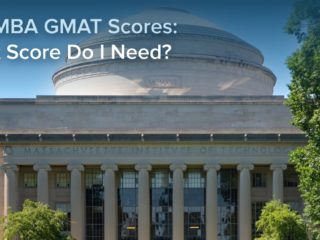| Getting your Trinity Audio player ready... |
If you’re interested in applying to top 20 full-time MBA programs, you may be looking at the McCombs School of Business at the University of Texas at Austin. The UT Austin McCombs MBA program was tied for #16 on U.S. News & World Report’s 2025 list of best business schools. It’s also the #1 full-time MBA program in Texas.
KEY FACT:
The UT Austin McCombs MBA program was tied for #16 on U.S. News & World Report’s 2025 list of the Best Business Schools.
To be competitive at a respected school like McCombs, you’ll want to do everything to make your application stand out. This includes having a great GMAT score. So, what exactly is a great GMAT score for UT Austin?
In this article, we’ll look at McCombs’ MBA GMAT score averages and answer some important questions about McCombs’ MBA admissions. We’ll discuss whether the GMAT is required, whether it’s better to submit a GMAT or GRE score, and the McCombs acceptance rate. We’ll also provide a simple strategy for setting your target GMAT score for UT Austin.
Here are the topics we’ll cover:
- Does UT Austin’s MBA Program Require GMAT Scores?
- Is the GMAT or GRE Better for UT Austin’s MBA Program?
- How Hard Is It to Get Into UT Austin’s MBA Program?
- McCombs MBA GMAT Scores: Class of 2022-2026
- What GMAT Score Do I Need for UT Austin’s MBA Program?
- In Conclusion
- What’s Next?
Let’s start by reviewing McCombs’ GMAT requirements.
Does UT Austin’s MBA Program Require GMAT Scores?
McCombs MBA may submit either a GMAT score or a GRE score for admission to the full-time program. McCombs waives the GMAT/GRE requirement in a few circumstances (for instance, if you submit an Executive Assessment score instead). You may even be allowed to submit a score that is more than 5 years old. That said, you should communicate with the admissions office directly if you’d like to pursue a waiver. Don’t assume that you will qualify or that you can submit an expired score. Get confirmation from an admissions officer!
KEY FACT:
Prospective McCombs MBA students can submit either a GMAT score or a GRE score when applying to the full-time program.
Of course, having the choice between either the GMAT or the GRE begs the question, which test is better for UT Austin’s MBA program?
Is the GMAT or GRE Better for UT Austin’s MBA Program?
Concerning the submission of GMAT or GRE scores, McCombs states, “The MBA Admissions Committee does not have a preference on which test you take.”
I believe that when a program makes such a statement, you can take the program at its word. There is no reason to believe that McCombs would solicit data from MBA applicants that it does not find valuable. However, if you still feel concerned that taking a certain test will put you at a disadvantage, don’t hesitate to reach out to the folks at admissions to get confirmation that they treat both tests equally. It’s worth the email or phone call if it puts your mind at ease.
Now, if you’re unsure which test would be more suited to your strengths and skills, the best thing you can do is take a full-length official practice exam of each, so you can see which test you perform better on.
KEY FACT:
McCombs states that there is no preference for either the GMAT or the GRE.
So, we know what McCombs’ testing requirements are, but what about how competitive the admissions process is? Let’s take a look.
How Hard Is It to Get Into UT Austin’s MBA Program?
One of the first questions students interested in applying to UT Austin McCombs ask is, “How competitive is the UT Austin MBA program?” Let’s take a look at the McCombs School of Business acceptance rate over the past few years.
McCombs MBA Acceptance Rate: Class of 2022-2026
The graph shows us that the classes of 2022 and 2023 had relatively high acceptance rates. This resulted from a decrease in the number of applicants, in part due to the Covid pandemic. The situation normalized in the ensuing three years, with acceptance rates leveling off to around 30%,
So, based on the data above (and barring anything truly unforeseen), it would be reasonable to expect that the acceptance rate at McCombs will be about 30% as we look at the class of 2027 and beyond.
KEY FACT:
In the post-pandemic years, the percentage of accepted MBA applicants at McCombs has hovered at about 30%.
Let’s now take a look at the types of GMAT scores admitted students have.
McCombs MBA GMAT Scores: Class of 2022-2026
The average GMAT scores of McCombs MBA students increased and then decreased during this 5-year period, with the McCombs class of 2023 hitting a record-high GMAT average of 708. Below are the average GMAT scores of McCombs MBA students in the full-time MBA program in the past 5 class years.
| Class Year | Average Total Score |
|---|---|
| 2026 | 704 |
| 2025 | 704 |
| 2024 | 706 |
| 2023 | 708 |
| 2022 | 704 |
Now, going by the numbers above, can you simply conclude that a (legacy) GMAT score of, say, 700-710 will make you a shoo-in at McCombs? Not quite. Case in point: we also know that the class of 2026 has a middle 80% GMAT score range of 650-740. The middle 80%, or “mid-80%,” means that 80% of the class scored in that range, 10% of the class scored below that range, and 10% of the class scored above that range.
So, some applicants were impressive enough to earn admission with a GMAT score that was lower than the school average. Others perhaps needed higher scores to earn a seat. How, then, can you determine where in the range you need to fall? Let’s discuss.
KEY FACT:
The average legacy GMAT score of McCombs students in the class of 2026 is 704, and the mid-80% range is 650-740.
What GMAT Score Do I Need for UT Austin’s MBA Program?
Generally speaking, a good GMAT score for an MBA program is equal to the average GMAT score of admitted students.
However, as we can see, accepted MBA students at McCombs have a pretty wide range of GMAT scores. In fact, such a range is not at all unusual for MBA programs in general. So, what explains the variability?
Well, while test scores are undoubtedly an important part of an MBA applicant’s profile, they are just one part. Admissions committees weigh numerous factors when considering applicants, from academic background and GPA to work experience and letters of recommendation-–not to mention application essays and personal background.
So, you too must weigh all of these factors when determining what GMAT score will make you competitive. Specifically, you should research the program’s most recent class profile to see how you stack up against admitted students in the areas mentioned above. Let’s look at some examples of the data you should weigh.
Analyzing Class Profile Data to Set Your Score Goal
When setting your GMAT score goal, you will need to consider the McCombs average GPA and work experience. For instance, the McCombs class of 2026 has an average undergraduate GPA of 3.48 and an average of 6 years of work experience. How do your GPA and work experience stack up against those? Assume your GPA is 3.4 and you have only 2.5 years of work experience. With these, shooting for a GMAT score that beats the class average is almost mandatory. Instead, say you have a GPA of 3.7 and an impressive 6-year work history. In that case, you may be perfectly comfortable aiming for a GMAT score of 700, right around the average.
You should also consider where you fit into the demographics of McCombs students. For example, people in groups that are typically overrepresented in MBA applicant pools generally need to earn higher GMAT scores than applicants with more unique backgrounds do. Think about it. If you are part of an overrepresented group, then there will be many applicants whose profiles look similar to yours. In that case, having a GMAT score that hits the average isn’t going to make your application stand out. However, earning a higher-than-average GMAT score could help you get noticed among a sea of similar applicants.
In general, the GMAT can be a powerful opportunity to compensate for any weak points in your applicant profile and stand out among your peers. So, consider the McCombs GMAT average a starting point, not an automatic goal. Then, evaluate the strengths and weaknesses of your profile compared to the McCombs MBA class profile. Finally, adjust your score goal up or down from there.
TTP PRO TIP:
Consider the McCombs GMAT average a starting point, not an automatic goal.
In Conclusion
Remember, you never want your score to be a reason admissions thinks twice about your candidacy. Rather, a good GMAT score can help you balance out any shaky aspects of your applicant profile.
Additionally, keep in mind the following general rules of thumb:
- If you’re in an overrepresented group, aim for a GMAT score that beats the McComb class average.
- If you’re in multiple overrepresented groups, aim for a score that nears the top end of the mid-80% GMAT range (or possibly surpasses it, depending on the other aspects of your application).
- If you’re in an underrepresented group, aim for a GMAT score that at least hits the McCombs class average.
- If your applicant profile is fairly unique or impressive in multiple respects, you may feel comfortable with a GMAT score below the class average. (Of course, only you can make that call — just make sure you’re viewing your application with an objective eye.)
TTP PRO TIP:
If you’re in an overrepresented group, aim for a GMAT score that beats the McComb average. If you’re in an underrepresented group, aim for a GMAT score that at least hits the average.
What’s Next?
Thinking of applying to other programs similar to the UT Austin McComb MBA program? Check out this guide to GMAT scores needed for business school.
Then take your GMAT prep to the next level with a free 5-day, full-access trial of the TTP GMAT Course. With personalized study plans and live, expert support, we’re here to help you reach your GMAT goal!



